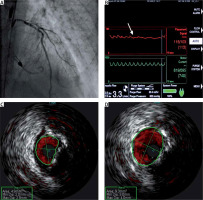A 58-year-old man, with a history of myocardial infarction, hypercholesterolemia, smoking, arterial hypertension, chronic obstructive pulmonary disease, paroxysmal atrial fibrillation, and stroke, was transferred from another hospital to our department to undergo high-risk percutaneous coronary intervention (PCI). Previously performed coronary angiography revealed a multi-vessel disease with significant stenosis of the left main (LM) and left ascending coronary artery (LAD), as well as occlusions of the right coronary artery and circumflex artery (Figure 1 A). Due to severely depressed left ventricular (LV) function (ejection fraction of 25%) and the need for complex PCI of the last remaining vessel, after the discussion with the heart team, he was scheduled for PCI with the support of a percutaneous left ventricular assist device (pLVAD) – so-called ‘protected PCI’ [1].
Figure 1
A – Baseline coronary angiography of the left coronary artery: heavy calcifications, occlusion of the circumflex artery and significant stenosis in the distal part of the left main artery (LM) and proximal segment of the left descending artery, B – blood pressure curve straightening after balloon inflation in the LM (arrow), C – significant stenosis of the LM imaged in intravascular coronary ultrasound (ICUS), D – ICUS confirming an optimal stent apposition

After the initial peripheral angiography confirming eligibility for using pLVAD, a 14 Fr sheath was inserted into the right femoral artery. The Impella CP system (Abiomed Inc., Danvers MA, USA) was delivered to the LV and started providing a cardiac output of 3.4 l/min. Subsequently, intravascular ultrasound (IVUS) guided PCI using the right transradial approach was started. During each balloon inflation, the curve of blood pressure measured in the ascending aorta was flattened (Figure 1 B), which meant that cardiac output was provided only by pLVAD. Eventually, a 3.5 × 48 mm drug-eluting stent was successfully implanted in the LM/LAD (Figures 1 C, D). The femoral artery was closed with the Perclose ProGlide closure system (Abbott Cardiovascular, Santa Clara, CA, USA). Further hospitalization was uncomplicated, and after 3 days, the patient was discharged home.
The Impella CP provides up to 4 l/min cardiac output covering 70–100% of the heart contractile function [2]. Therefore, the arterial pressure drops during the described procedure did not manifest themselves either as severe cardiac arrhythmias or cardiac arrest. The operator was able to continue the intervention, prepare highly calcified and complex lesions, and apply advanced percutaneous techniques, resulting in good stent apposition. As the introduction of Impella CP is relatively easy and safe, we assume that this device should be used more often in carefully selected patients, especially since the national healthcare system in Poland reimburses its use during high-risk PCIs [3]. The heart team consultation should help in choosing patients who will benefit from this technology the most.








